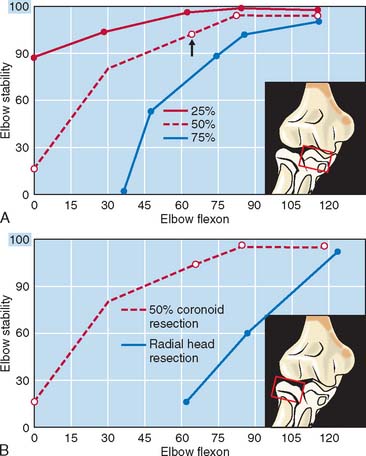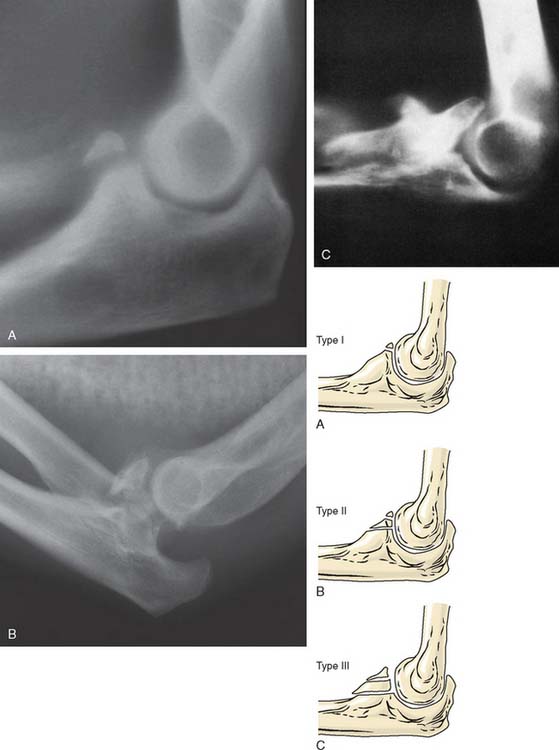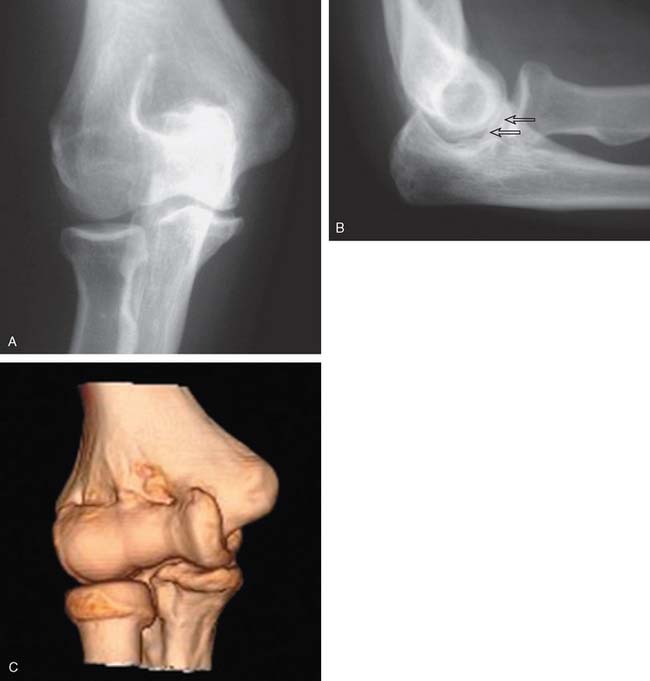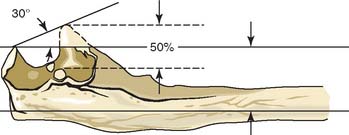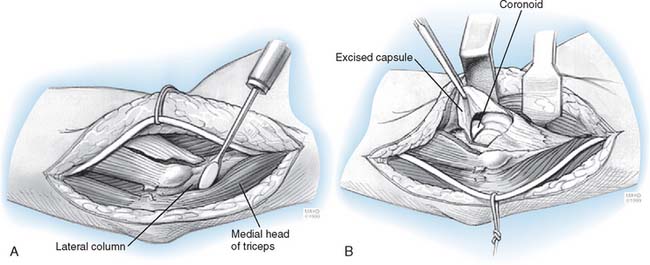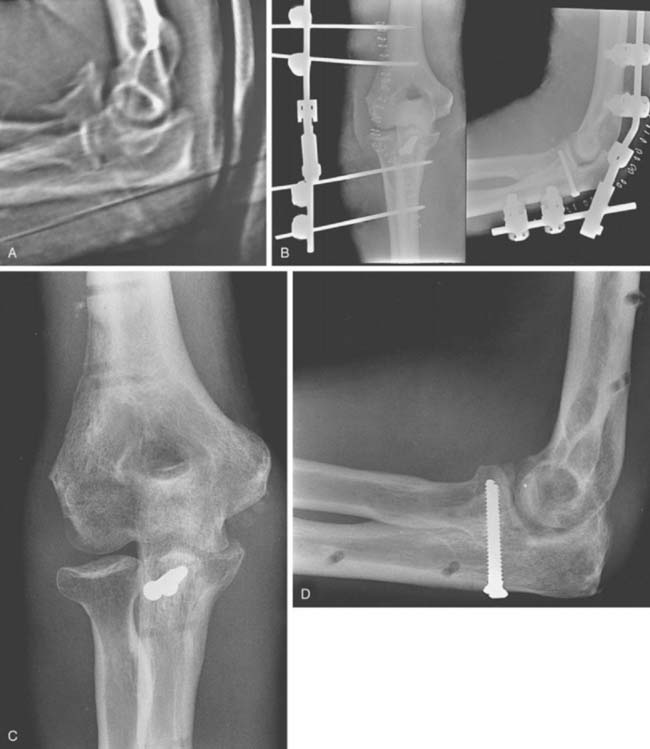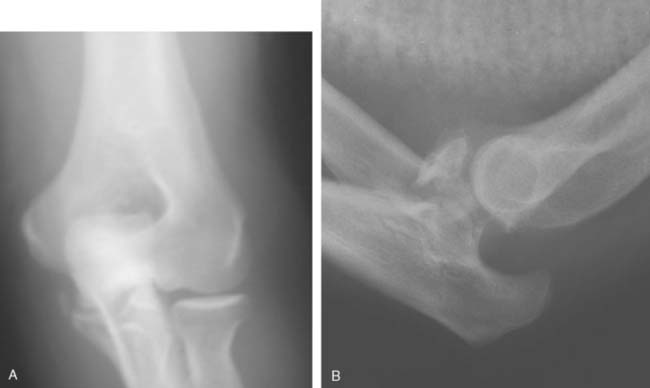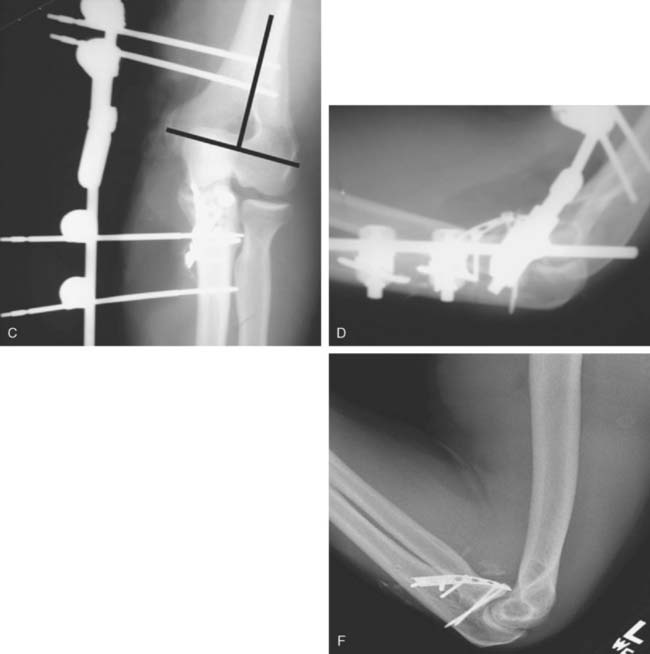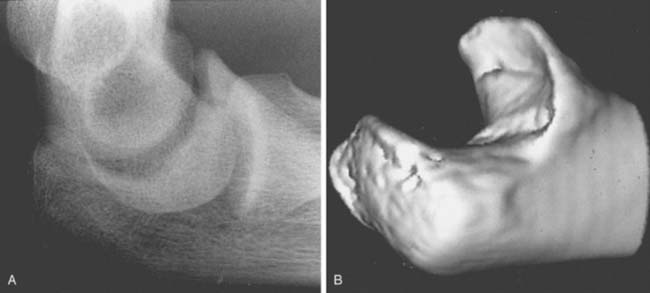CHAPTER 27 Coronoid Process and Monteggia Fractures
THE CORONOID
As this fracture often occurs in conjunction with radial head fractures and dislocation; it is also discussed in the chapter on complex instability (see Chapter 29).
MECHANISM OF INJURY
Isolated coronoid fractures are uncommon and usually occur in association with elbow dislocation.49,59 One recent review of 120 complex elbow injuries identified 21% with coronoid and radial head fractures, 19% with olecranon and radial head fracture and 33% with radial head, olecranon and coronoid fracture.20 One group identified three of eight isolated coronoid fractures.23 Theoretically, the coronoid is fractured with the elbow in 0 to 20 degrees of flexion during an axial load (Fig. 27-1).1 This is a mechanism similar to that in elbow dislocation. With flexion past 30 degrees, radial head fractures occur. The combination of coronoid and radial head fracture has important implications for treatment, as discussed in Chapter 29. Of particular note is the fact that fractures involving more than 50% of the coronoid (Regan/Morrey type II) are associated with marked elbow instability, especially if the radial head has been resected (Fig. 27-2).12,13,36
INCIDENCE
Fractures of the coronoid process are uncommon. This may occur with a comminuted olecranon or proximal ulnar fracture (Fig. 27-3). The injury has also been reported in 2% to 10% of patients with dislocation of the elbow. Our review of 293 acute radial head fractures documented 33 (11%) concurrent coronoid fractures (see Chapter 24).64 Since the initial series of 35 patients,49 a few case reports19,61 and small series have appeared.23,31,56
CLASSIFICATION
Review of Mayo records resulted in a simple classification of coronoid fractures as well as a rationale for treatment (Fig. 27-4). Type I is a fracture of the tip of the coronoid process caused by a shearing force as the coronoid process subluxates or dislocates over the trochlea. A type II injury involves a single or comminuted fragment constituting about half of the coronoid. A type III fracture involves more than half of the coronoid process. The type II or III fracture may be comminuted, and all three may be associated with dislocation of the elbow or with other injuries. Comminution in the sagittal plane, often involving the medial portion of the coronoid and sometimes even involving the sublime tubercle, has been documented58 (Fig. 27-5). Subtle medial coronoid fractures have also been documented. A hint of such an injury is the appearance of the so-called double crescent sign (Fig. 27-6).
ASSOCIATION INJURIES
With type I fractures, or any coronoid fracture, one must assume that the elbow has dislocated. Even if dislocation did not occur, some injury to the ligament is present, even if only a strain. Furthermore, 35% of the patients with type I, 56% of the patients with type II, and 80% of the patients with type III coronoid fractures had other identified injuries.49 In fact, today an isolated injury is considered a rarity and other pathology must be sought if it is not obvious.
Our current management philosophy is governed by our clinical experience and by basic investigational data (see Chapter 3).26,31,37,46 Simply put, first and foremost, a stable ulnohumeral joint must be attained and maintained. This means
TREATMENT
Authors’ Preference
Type I
The patient with type I fracture is treated according to the concurrent pathology. The fracture itself indicates that the elbow has dislocated and should be managed on that basis. One recent report has implicated the fragment as a source of catching or impingement, both responding to arthroscopic excision.29 It does not need to be fixed acutely.
Type II
Type II fractures should be treated with early motion unless the elbow is unstable. Typically involving more than 50% of the coracoid, screw fixation is effective if the fragment is not comminuted. If comminuted, a suture or a buttress plate are both effective options, and a distraction device can be used to provide the initial stability while the soft tissue heals. Fixation of the smaller fragments alone may not stabilize the joint but should be considered if technically feasible. As a useful clinical tool, we have observed that determining the rotational stability is assisted by a line from the tip of the olecranon through the residual coronoid. If this is parallel to the long axis of the ulna, a type II or a 50% fracture has occurred and the joint is potentially unstable (Fig. 27-7).
Type III
Type III fractures are always associated with elbow instability. If the fracture is comminuted and is not amenable to fixation, the suture or buttress plate options are employed and an external fixation device is mandatory. Failure to stabilize the elbow in type III fractures results in a painful subluxation of the ulnohumeral joint, usually with marked limitation of motion (Fig. 27-8). Hence, open reduction and rigid fixation, with or without the distraction device, remains the treatment of choice.
Note: The most important point is that the acute injury must be properly managed. Outcomes of acute management are orders of magnitude better than those of delayed reconstruction.23,42,52,56,67
Technique
If the radial head is fractured or the elbow is grossly unstable, exposure and fixation of the coronoid is facilitated. We still usually use a straight posterior skin incision. Kocher’s interval is used if the radial head is fractured. If the fracture is an isolated one, a medial approach is used (see Chapter 7). This is mandatory if a sagittal component is present and if the medial collateral ligament is involved.
With the use of the posterior incision, the ulnar nerve is exposed but not transferred. The flexor-pronator origin is released with a 1-cm cuff of tendon left on the medial epicondyle (Fig. 27-9). The brachialis muscle is elevated from the capsule, and the joint entered. Fixation is ideally accomplished with one or two compression screws (Fig. 27-10). With comminuted fractures, a heavy No. 5 nonabsorbable suture may be placed through the brachialis tendon, and then through the fracture, and is secured through drill holes in the ulna through the base of the fracture (Fig. 27-11). A buttress plate is also effective (Fig. 27-12).
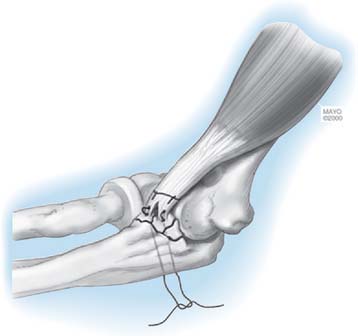
FIGURE 27-11 A suture through the brachialis tendon may be used to secure badly comminuted fracture fragments.
Reconstruction
An absent coronoid may be reconstructed with a well-fashioned bone graft from the ilium. Moritomo and colleagues35 have also described reconstruction with the osteotomized portion of the olecranon. But in general, reconstruction is unreliable. Using an osteochondral graft is successful in only about 50% of cases. More complex reconstruction has also been assessed42 with better outcomes being realized if the coracoid, radial head, and collateral ligaments are all addressed at the time of the injury.42,53,54
RESULTS
The results of 35 patients with acute coronoid fractures treated at Mayo are shown in Table 27-1. Using an elbow performance index, it is obvious that the chance of a satisfactory result directly correlates with the severity of the injury, as reflected by the coronoid fracture type. Pain is uncommon in type I and typical in type III injury. Our impression is that the results have improved over the last decade owing to (1) a better understanding of the implications of associated injury, (2) more aggressive exposure, and (3) improved design of internal and external fixation systems. Hence, the reports by both Ring et al55 and Pugh et al46 on 80% satisfactory outcomes following the above-mentioned principles when employed for acute fracture management.
Stress Fracture
Although reported for the olecranon,30,68 stress fracture has not been reported for the coronoid. We have, however, documented one instance occurring in a young 17-year-old female gymnast (Fig. 27-13). Symptoms resolved and full activity returned with cessation of activity for 3 months.
MONTEGGIA FRACTURE
Giovanni Battista Monteggia of Milan first described the injury that bears his name in 1814,33 the same year that Colles described his fracture. Monteggia initially reported on a fracture of the ulna associated with anterior dislocation of the radial head, which is today recognized as the most common of the Monteggia lesions, a term coined by Bado4 that includes all ulnar fractures associated with dislocations of the radiocapitellar articulation. These lesions are uncommon (7% of ulnar fractures, 0.7% of elbow injuries5) but are difficult to manage properly.
CLASSIFICATION
Depending on the type of dislocation of the radial head (anterior, posterior, and lateral), three distinct types of injuries were recognized early. Bado4 subsequently proposed a classification that encompasses the full spectrum of these injuries and has become universally accepted.
Type I
Type I injury is an anterior dislocation of the radial head associated with a fracture of the ulnar diaphysis at any level with anterior angulation (Fig. 27-14). This is the most common type of lesion (55% to 78% of Monteggia fractures, depending on the series) and is most common in children.
Stay updated, free articles. Join our Telegram channel

Full access? Get Clinical Tree



